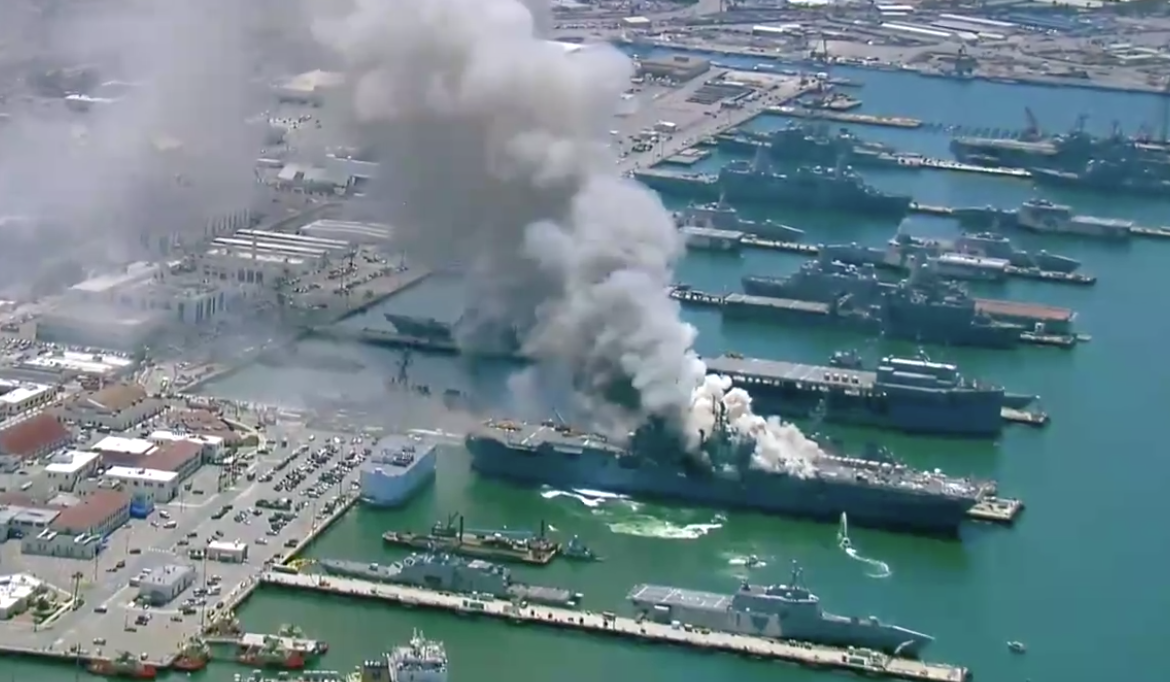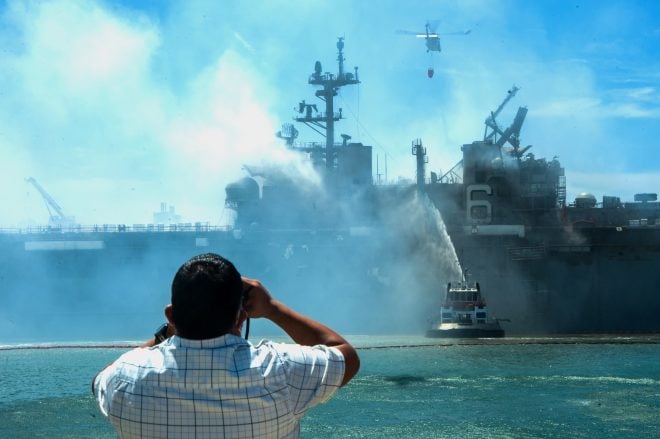the concerned
Active Member
Do they not have the option of towing it out to open waters and sinking it rather than waiting for the fuel to go up.
A tough call, a mess in San-Diego harbour or off the California coast. I believe the ship is GT powered so this fuel (3000 tons as Swerve mentioned) is basically a big bomb parked in the harbour. I guess there is no safe way to off-load until the fire is out.I don’t believe the USN would want to sink it with over 1Mil gallons of fuel onboard. Plus all of the other environmentally hazardous materials aboard.
Not needed yet and things are looking up.Do they not have the option of towing it out to open waters and sinking it rather than waiting for the fuel to go up.

She's steam powered; only Makin Island, the last ship of the class, had GTs. Her propulsion fuel would be either dieso (most likely) or possibly AVCAT (FFO, Bunker B or whatever you want to call it hasn't been used for years). There looks to be very little risk of a major fuel fire at present and, while the damage does look severe, it would be a brave person who decided to throw away a couple of billion dollars worth of ship before the damage was even surveyed. That's apart from the potential environmental issues others have raised.A tough call, a mess in San-Diego harbour or off the California coast. I believe the ship is GT powered so this fuel (3000 tons as Swerve mentioned) is basically a big bomb parked in the harbour. I guess there is no safe way to off-load until the fire is out.
Is there a congressionally mandated number of LHD/LHA? Including USS Bonhomme Richard there are currently 8 commissioned Wasp-class and 1 commissioned America-class, but USS Tripoli commissions tomorrow. Assuming 9 LHD/LHA are the minimum required, there shouldn't be any need to reactivate a Tarawa even with USS Bonhomme Richard down. Can the F-35B even operate effectively on a Tarawa's smaller flight deck, otherwise they would only be helicopter carriers? In this case it's a good thing they didn't deactivate USS Wasp ahead of USS Tripoli's commissioning unlike say USS Enterprise's deactivating ahead of USS Gerald R. Ford. It'll be interesting to see whether it ends up being cheaper to extend the life of the USS Wasp or repair the USS Bonhomme Richard.It's going to be an interesting decision for the USN, rebuild or pay off. The fact she is only one of about half a dozen ships with oil fired steam plants might well play in that decision, as will several other things I suspect - prestige, costs of repair, cost of not having the capability, her age, cost of repair vs cost of reactivating one of the Tarawa class (three of which are still in reserve) are some.
No. One part of the Bonhomme Richard upgrade (which now went up in flames) was to enable it to operate F-35B.Can the F-35B even operate effectively on a Tarawa's smaller flight deck, otherwise they would only be helicopter carriers? .

Good read, the outcome of the fingering pointing wrt to blame will be interesting, especially as there were probably many contractors doing jobs on the ship at varying times.USNI update on the Bonhomme Richard.

UPDATED: 21 Taken to Hospitals as Firefighting Effort Continues in USS Bonhomme Richard Fire - USNI News
This is the final version of this post. Click here for continued USNI News coverage of the fire on USS Bonhomme Richard (LHD-6). SAN DIEGO, Calif. – A fire that broke out Sunday morning in amphibious assault ship USS Bonhomme Richard (LHD-6) sent 17 sailors and four civilian workers to local...news.usni.org
I can only see holes clear through the top of the Super Structure (that might just be my bad eyesight) not the Flight Deck. Is it possible, like quite a few warships out there, she has an Aluminium Super Structure?images from the site now showing areas where the fire has completely burned through the flight deck in several areas, One has to wonder if she’s a total loss at this point. Fortunately no loss of life so far
View attachment 47494View attachment 47495
View attachment 47495
This is the latest USNI update and in the photo from above you can see the large hole burnt in the flight deck.I can only see holes clear through the top of the Super Structure (that might just be my bad eyesight) not the Flight Deck. Is it possible, like quite a few warships out there, she has an Aluminium Super Structure?

Sorry are you talking about the last photo in the article? Because that's the top of the Super Structure. Just behind where the mast has collapsed. The photos description says superstructure.This is the latest USNI update and in the photo from above you can see the large hole burnt in the flight deck.

Navy Fighting 2 ‘Major’ Fires on USS Bonhomme Richard as Battle Enters Third Day - USNI News
SAN DIEGO, Calif. – Sailors and firefighting crews are still battling two “major” fires aboard USS Bonhomme Richard (LHD-6), three days after a fire sparked and quickly spread throughout the amphibious assault ship, Navy officials said on Tuesday. One of the fires is in the forward part of the...news.usni.org
If you look at the last photo, just forward and portside of the island there are two holes burnt through the flight deck - 1 medium and 1 small. Go forward along the flight deck and the third hole that has burnt through is quite large, almost the width of the flight deck. You can't miss them because they very prominent.Sorry are you talking about the last photo in the article? Because that's the top of the Super Structure. Just behind where the mast has collapsed. The photos description says superstructure.
One of the things which had read was that the onboard halon fire suppression system was disabled or turned "off" during the upgrades, and that since the vessel was still in a maintenance cycle it had not been turned back on yet. That alone would make a large difference in the outcome.It is staggering to an amateur like myself that a fire could get so out of control on a steel warship. I presume the big open hanger space was a key factor but could this happen on a more compartmentalised ship like a destroyer.
I seem to recall reading that in the Falklands conflict that heat of a fire in one compartment could transfer to the next compartment and start a fire without actually penetrating the bulkhead
It can be quite quick for a fire a fire to gain a foothold in a warship. It's not the steel that burns, but all the inflammable stuff found inside warships, such as fuels, oils,lubricants, fittings, furnishings, plastics etc. When a fire starts aboard a ship you have 7 minutes to extinguish it. If you don't, for every 7 minutes it burns it will take you an hour of fighting it to extinguish it. You are right about the Falklands. It's called radiant heat energy transfer and if the heat energy transfer is enough to raise the temperature of a object in the adjacent compartment past its ignition point, it will catch fire as it absorbs more heat. If the fire in a ship gets hot enough it has the potential to melt steel.It is staggering to an amateur like myself that a fire could get so out of control on a steel warship. I presume the big open hanger space was a key factor but could this happen on a more compartmentalised ship like a destroyer.
I seem to recall reading that in the Falklands conflict that heat of a fire in one compartment could transfer to the next compartment and start a fire without actually penetrating the bulkhead
